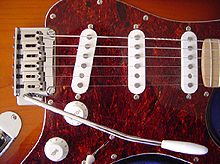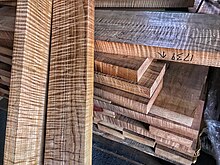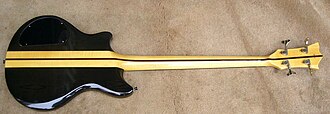Electric guitar
The sound is sometimes shaped or electronically altered to achieve different timbres or tonal qualities via amplifier settings or knobs on the guitar.Early proponents of the electric guitar on record include Les Paul, Eddie Durham, George Barnes, Lonnie Johnson, Sister Rosetta Tharpe, T-Bone Walker, and Charlie Christian.[1] It has evolved into an instrument that is capable of a multitude of sounds and styles in genres ranging from pop and rock to folk to country music, blues and jazz.Electric guitar design and construction varies greatly in the shape of the body and the configuration of the neck, bridge, and pickups.[5] Coils that were wrapped around a magnet would create an electromagnetic field that converted the vibrations of the guitar strings into electrical signals, which could then be amplified.Commercial production began in late summer of 1932 by the Ro-Pat-In Corporation (Electro-Patent-Instrument Company), in Los Angeles,[6][7] a partnership of Beauchamp, Adolph Rickenbacker (originally Rickenbacher), and Paul Barth.[13] Early electric guitar manufacturers include Rickenbacker in 1932; Dobro in 1933; National, AudioVox and Volu-tone in 1934; Vega, Epiphone (Electrophone and Electar), and Gibson in 1935 and many others by 1936.[14][9][10][11][12] The Electro-Spanish Ken Roberts was revolutionary for its time, providing players a full 25-inch scale, with easy access to 17 frets free of the body.[15] The Electro-Spanish Ken Roberts was also the first instrument to feature a hand-operated vibrato as a standard arrangement,[15] a device called the "Vibrola", invented by Doc Kauffman.A functioning solid-body electric guitar was designed and built in 1940 by Les Paul from an Epiphone acoustic archtop as an experiment.The feedback associated with amplified hollow-bodied electric guitars was understood long before Paul's "log" was created in 1940; Gage Brewer's Ro-Pat-In of 1932 had a top so heavily reinforced that it essentially functioned as a solid-body instrument.[21] In 1946, Merle Travis commissioned steel guitar builder Paul Bigsby to build him a solid-body Spanish-style electric.[23] Another notable solid-body design is the Fender Stratocaster, which was introduced in 1954 and became extremely popular among musicians in the 1960s and 1970s for its wide tonal capabilities and more comfortable ergonomics than other models.[25][26][27] The most recent electric guitar on this list was the Ibanez Jem (1987) which featured "24 frets", an impossibly thin neck" and was "designed to be the ultimate shredder machine".Numerous other important electric guitars are on the list, including Gibson ES-150 (1936), Fender Telecaster (1951), Gibson Les Paul (1952), Gretsch 6128 Duo Jet (1953), Fender Stratocaster (1954), Rickenbacker 360/12 (1964), Van Halen Frankenstrat (1975), Paul Reed Smith Custom (1985) many of these guitars were "successors" to earlier designs.Some otherwise solid-bodied guitars, such as the Gibson Les Paul Supreme, the PRS Singlecut, and the Fender Telecaster Thinline, are built with hollow chambers in the body.Many models, known as semi-hollow bodies, have a solid block running through the middle of the soundbox designed to reduce acoustic feedback.Some steel-string acoustic guitars include a built-in system to electrically amplify their output without altering their tone as an alternative to using a separate microphone.Electric guitar design and construction vary greatly in the shape of the body and the configuration of the neck, bridge, and pickups.The degree to which the choice of woods and other materials in the solid-guitar body (3) affects the sonic character of the amplified signal is disputed.Some studio instruments, notably certain Gibson Les Paul models, incorporate a low-impedance three-pin XLR connector for balanced audio.Pictured is a tremolo arm or vibrato tailpiece-style bridge and tailpiece system, often called a whammy bar or trem.Because of their natural qualities, magnetic pickups tend to pick up ambient, usually unwanted electromagnetic interference or EMI.[35] This mains hum results in a tone of 50 or 60 cycles per second depending on the powerline frequency of the local alternating current supply.Double-coil or "humbucker" pickups were invented as a way to reduce or counter the sound, as they are designed to "buck" (in the verb sense of oppose or resist) the hum, hence their name.String gauge and design, neck construction and relief, guitar setup, playing style, and other factors contribute to the subjective impression of playability or feel.Today there are expensive and budget guitars exploring other options for fretboard wood for instance Pau-Ferro, both for availability and cheap price while still maintaining quality.Aside from possible engineering advantages, some feel that with the rising cost of rare tonewoods, human-made materials may be economically preferable and more ecologically sensitive.Few, if any, extensive formal investigations have been widely published that confirm or refute claims over the effects of different woods or materials on the electric guitar sound.The fingerboard surface usually has a cross-sectional radius that is optimized to accommodate finger movement for different playing techniques.





1.1 machine heads
1.2 truss rod cover
1.3 string guide
1.4 nut
2. Neck
2.1 fretboard
2.2 inlay fret markers
2.3 frets
2.4 neck joint
3. Body
3.1 "neck" pickup
3.2 "bridge" pickup
3.3 saddles
3.4 bridge
3.5 fine tuners and tailpiece assembly
3.6 whammy bar (vibrato arm)
3.7 pickup selector switch
3.8 volume and tone control knobs
3.9 output connector (output jack)( TS )
3.10 strap buttons
4. Strings
4.1 bass strings
4.2 treble strings








Electric guitar (disambiguation)Gibson Les Paul CustomString instrumentGuitarsolid-body guitarClassificationfingeredpickedstrummedHornbostel–Sachs classificationchordophonePlaying rangeChuck Berryelectricsound amplificationacoustic guitarpickupselectrical signalsloudspeakerstimbreseffectsreverbdistortion and "overdrive"heavy metalsemi-acousticacoustic-electricjazz guitarguitar solosbig bandLes PaulEddie DurhamGeorge BarnesLonnie JohnsonSister Rosetta TharpeT-Bone WalkerCharlie Christianpopular musiccountry musicelectric bluesrock and rollrock musicheavy metal musicbridgea spring-loaded hinged bridgevibratonew playing techniquesstring bendingtappinghammering-onaudio feedbackslide guitarsemi-acoustic guitarssolid bodysix-string guitarseven-string guitareight-string guitartwelve-string guitarcoursesmandolinrhythm guitarprogressionsrhythm sectionlead guitarmelodyinstrumental fillpower triobanjoscarbon button microphonesarchtoptransducersaluminiumlap steel guitar"Frying Pan"George BeauchampNational Stringed Instrument CorporationAdolph RickenbackerRo-Pat-In CorporationRickenbackerAudioVoxEpiphoneGibsonElectro-Spanish Model BElectro-Spanish Ken Robertshand-operated vibratoDoc Kauffmansolid-bodySpanish standard guitarVivi-ToneBakeliteSlingerlandES-150Gibson Les PaulTed McCartyFender Stratocasteramplifierspeakerwolf tonesfeedbackpolymerMerle TravisPaul BigsbyFender EsquireFender BroadcasterFender Telecasterprototypesingle-coilhumbuckerGuitar WorldGage BrewerWichita, KansasIbanez JemVan Halen FrankenstratGibson SGAngus YoungFender Telecaster ThinlineSemi-acoustic guitarindie rockF-shaped sound holessteel string acoustic guitarAcoustic-electric guitarsteel-string acoustic guitarspiezoelectricmicrophoneelectric acoustic guitarsHeadstockmachine heads